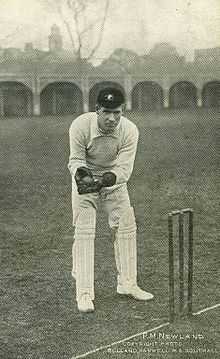Phil Newland
 | |||||||||||||||||||||||||||
| Personal information | |||||||||||||||||||||||||||
|---|---|---|---|---|---|---|---|---|---|---|---|---|---|---|---|---|---|---|---|---|---|---|---|---|---|---|---|
| Full name | Philip Mesmer Newland | ||||||||||||||||||||||||||
| Born |
2 February 1875 Kensington, South Australia | ||||||||||||||||||||||||||
| Died |
11 August 1916 (aged 41) Westbury, Tasmania | ||||||||||||||||||||||||||
| Batting style | Right-handed batsman | ||||||||||||||||||||||||||
| Role | Wicket-keeper | ||||||||||||||||||||||||||
| Domestic team information | |||||||||||||||||||||||||||
| Years | Team | ||||||||||||||||||||||||||
| 1899-1905 | South Australia | ||||||||||||||||||||||||||
| Career statistics | |||||||||||||||||||||||||||
| |||||||||||||||||||||||||||
| Source: CricketArchive | |||||||||||||||||||||||||||
Philip Mesmer "Phil" Newland (2 February 1875 – 11 August 1916) was an Australian sportsman who excelled at Australian rules football, cricket and lacrosse. He played Sheffield Shield cricket for South Australia as a wicket-keeper and toured England with the Australian Test team in 1905.
He was a member of the noted Newland family of South Australia. His father was author Simpson Newland and he was the brother of surgeon Henry Simpson Newland and politician Victor Marra Newland.
Newland made his first-class and Sheffield Shield debut in 1899/00 but had to wait over two years to make his second appearance.[1] He took part in every Shield campaign from 1902/03 to 1905/06 and usually batted in the lower order. His highest score of 77 was made on the Adelaide Oval, in a 106 run ninth wicket partnership with spinner Robert Rees.[2]
Up until 1904, when he retired from lacrosse, Newland represented South Australia in the sport and was earlier a leading player for Adelaide University.[3] He was also an Australian rules footballer, playing with the Norwood Football Club in the South Australian Football Association.[4] Newland captained Norwood's 1904 premiership team, which had come back from 35 points at the last change to win.[5]
Newland toured England in 1905 as a reserve wicket-keeper and understudy to Jim Kelly. While in the United Kingdom he played in 10 first-class matches with the Australian team, but could only score 67 runs at 9.57 and effect 13 dismissals.[6] His disappointing performances may have been as a result of an eye injury he received during the trip over, which was bad enough that he had to see an oculist in London.[7] He had earlier, in 1904/05, toured New Zealand and played two matches against the national team. At that stage, New Zealand weren't a Test playing country so the matches had only first-class status.[8]
References
- ↑ "First-Class Matches played by Philip Newland (28)". CricketArchive.
- ↑ "South Australia v New South Wales". CricketArchive.
- ↑ Wanganui Herald, "Notes About The Australian Team", 19 January 1905. p. 6
- ↑ The Hobart Mercury, "Personal", 17 August 1916. p. 6
- ↑ "Norwood's Amazing Comeback". Full Points Footy.
- ↑ "First-class Batting and Fielding for Australians". CricketArchive.
- ↑ Launceston Examiner, "Injury To Newland", 17 June 1905. p. 7
- ↑ "Australia in New Zealand and Fiji 1904/05". CricketArchive.